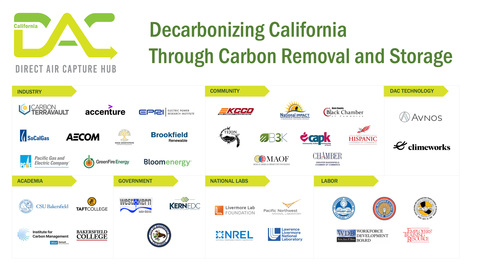Carbon TerraVault Holdings, LLC Announces California DAC Hub Consortium to Bring Direct Air Capture and Storage to the Golden State
Consortium Accelerates California’s Climate Leadership and Offers Transformative Benefits to Local Communities

California DAC Hub will help accelerate the Golden State’s climate leadership and achieve its carbon neutrality goal, and prioritize surrounding under-represented
Non-profit energy research and development institute EPRI intends to submit an application to the
Following Governor Gavin Newsom’s call for more ambitious climate action, the
The blueprint for expanding DAC+S throughout
-
The High Road Training Partnerships (HRTP) initiative, a
$10 million San Joaquin Valley include “High Road to Manufacturing in San Joaquin Valley” and “High Road to Regional Workforce Strategies: Kern County.” -
The
Community Economic Resilience Fund (CERF), a program created to promote a sustainable and equitable recovery from the economic distress of COVID-19 by supporting new plans and strategies to diversify local economies and develop sustainable industries that create high-quality, broadly accessible jobs for all Californians. CERF has named theKern Coalition one of 13 High Road Transition Collaboratives to receive funding.Kern Coalition is a partnership between Better Bakersfield and Boundless Kern (B3K Prosperity),Community Action Partnership of Kern (CAPK),Kern Inyo and Mono Central Labor Council , Building Healthy Communities, and Kern CCD. -
Two Local Energy Action Plan (LEAP) grants awarded by the
DOE to support locally tailored pathways to clean energy for the County ofKern andCity of Bakersfield . -
$50 million California Renewable Energy Laboratory (CREL) at Kern CCD to support the energy industry in the region with four projects: 1)Carbon Dioxide Reduction Center of Excellence , 2) Clean Energy andGrid Resilience Center of Excellence , 3)Clean Transportation Center of Excellence , and 4)Workforce Innovation and Learning Center . These four centers will partner with the District’s colleges to provide formal and informal learning opportunities for the region’s community centered on energy, including living laboratories featuring new technologies used in microgrids and carbon dioxide removal. CREL also has the mission to partner with local industry to identify transitional opportunities for the region’s workforce and develop professional opportunities to upskill and reskill the incumbent workforce. -
$83 million California State University, Bakersfield (CSUB) Energy Innovation Center, an incubator for science, research and technology that will bring together CSUB faculty and students, in partnership with industry and community leaders. The Center will contain CSUB’sCalifornia Energy Research Center , expanded fabrication lab, faculty and staff offices, and serve as the home base to up to 30 degree programs of the Schools of Natural Science, Mathematics and Engineering and Extended Education and Global Outreach. -
A
$2.5 million Kern County initiatives including the establishment of theCRC Carbon Management Institute with Kern CCD, a first-of-its-kind initiative that will empower local private and public partnerships to lead the way in defining how collaboration between education and industry can positively impact communities; the launch of the CRC Energy Transition Lecture Series at CSUB on relevant topics and emerging issues related to CCS and technologies that will lead the way to achieving a net zero future, and the establishment of the CRC Carbon TerraVault Scholarship to help provide CSUB students with academic opportunities.
Led by CTV Direct, Kern CCD and EPRI, the consortium includes the following organizations and may expand as appropriate based on further community engagement and future regional hub locations: Industry – Accenture, AECOM, Bloom Energy, Brookfield Renewable, Carbon TerraVault, EPRI, GeothermEx, GreenFire Energy, Pacific Gas and Electric (PG&E), Sage Geosystems, and Southern California Gas Company (SoCalGas); Technology – Avnos and Climeworks; Academia –
“Governor Newsom has set the most ambitious targets for
“The ‘community’ in community colleges is a real answer for good jobs with equity and the development of the future energy workforce,” said
“Preserving affordability and reliability on the path to net-zero rests on deploying every tool in the carbon reduction toolbox,” said
“It is very exciting that these organizations are working together cross-functionally to not only provide a carbon removal and storage solution but doing so using low carbon energy and providing economic benefits to
CTV is committed to engaging with our community-based organizations and including them throughout the development of the California DAC Hub and future associated regional hubs. Open and meaningful dialogue with our diverse stakeholders is a priority for the consortium as we expand participation of organizations and local communities.
About
About EPRI
Founded in 1972, EPRI is the world's preeminent independent, non-profit energy research and development organization, with offices around the world. EPRI's trusted experts collaborate with more than 450 companies in 45 countries, driving innovation to ensure the public has clean, safe, reliable, affordable, and equitable access to electricity across the globe. Together, we are shaping the future of energy.
About
Cautionary Note Regarding Forward-Looking Statements
This press release contains statements that we believe to be “forward-looking statements” within the meaning of Section 27A of the Securities Act of 1933 and Section 21E of the Securities Exchange Act of 1934. All statements other than historical facts are forward-looking statements, and include statements regarding our future financial position, business strategy, projected revenues, earnings, costs, capital expenditures and plans and objectives of management for the future. Words such as “expect,” “could,” “may,” "anticipate,” “intend,” “plan,” “ability,” “believe,” “seek,” "see,” “will,” “would,” “estimate,” “forecast,” “target,” “guidance,” “outlook,” “opportunity” or “strategy” or similar expressions are generally intended to identify forward-looking statements. Such forward-looking statements are subject to risks and uncertainties that could cause actual results to differ materially from those expressed in, or implied by, such statements. Although CRC believes the expectations and forecasts reflected in our forward-looking statements are reasonable, they are inherently subject to numerous risks and uncertainties, most of which are difficult to predict and many of which are beyond our control. No assurance can be given that such forward-looking statements will be correct or achieved or that the assumptions are accurate or will not change over time. Particular uncertainties that could cause our actual results to be materially different than those expressed in our forward-looking statements include, but are not limited to: legislative or regulatory changes, including those related to direct air capture and the availability of related tax credits; our ability to successfully develop and finance direct air capture projects, including our ability to obtain funding from the federal government and other financing sources; availability or timing of, or conditions imposed on, permits and approvals necessary for direct air capture and other carbon management projects; and the other risks and uncertainties set forth in the CRC’s Annual Report on Form 10-K for the year ended
View source version on businesswire.com: https://www.businesswire.com/news/home/20230207005539/en/
818-661-6014
Richard.Venn@crc.com
818-661-3731
Joanna.Park@crc.com
Source:







